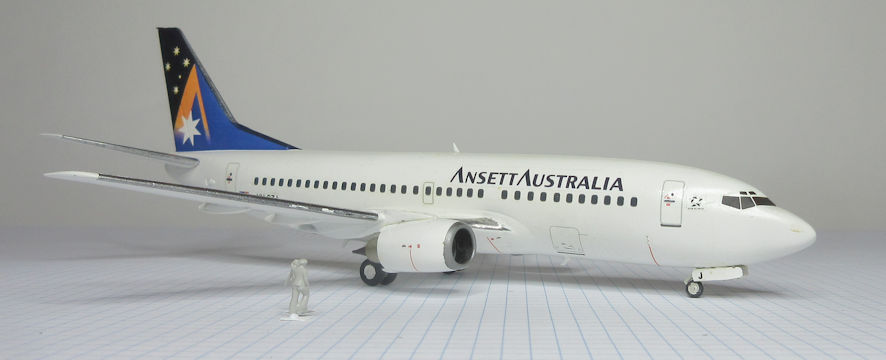Ansett’s Boeing Airliners
Boeing 727-100 – Boeing 727-200 – Boeing 737-300
I don’t suppose you will be surprised to learn that the Gallery of Airliners is one of my happy places. They are generally big aircraft designed to make people happy by bringing them together or taking them on holidays. Thus it was that I found myself wandering around among the big silver and white machines when I came to the Ansett-ANA Boeing 727-100, the first aircraft to fly turbojet powered scheduled airline service in Australia. ‘I wonder what other Andett Boeings we have’, I thought as I went to find out. It turns out that there are more than three in the Gallery already, but here are three interesting and related ones.
Boeing 727-100 (Ansett-ANA, VH-RME) in 1/144 by Airfix with Hawkeye decals
Due to the Australian government’s airline policy the nation’s main carriers were prohibited from flying turbojet airliners until 1964. At that time the two competing airlines, Ansett-ANA and TAA were allowed to import the same aircraft, Boeing 727-100s, and fly them on more or less parallel services. Which airline would start first was decided on the toss of a coin so Ansett-ANA’s VH-RME was first into service by about ten minutes. This airliner proved so successful that Ansett was later allowed to import the larger Boeing 727-200.
This kit has not been available for many years because Airfix upgraded its moulds to Boeing 727-200 standard. Fortunately for me I came across a few of the old 727-100 kits, of which this is one. For many years it was only possible to make a 727-100 by shortening the fuselage of a 727-200 kit but recently Revell have polished up their ancient kit of the 727-100 and it is fairly readily available. Whether it is a better offering that the Airfix kit I can’t say. If that isn’t available there are the Airfix and Minicraft kits that are easily converted to -100s by shortening the fuselage to make it the appropriate length.
Boeing 727-200 (Ansett Australia, VH-ANB) in 1/144 by Airfix with Hawkeye decals
After a few years the rapid growth in Australia’s airline passenger numbers made it necessary to increase capacity so both major domestic airlines were permitted by the government to import Boeing 727-22s. The main difference between them and the earlier 727s was an increase of 50 in their passenger capacity. Between the arrival of the first 727-100s Ansett had gone through several name changes and had become Ansett Australia to distinguish itself from the new Ansett International.
This kit is the Airfix 1/144 Boeing 727-200 which, along with the Minicraft kit of the 727-200, are a staple of scale model airliner collections. This model was made straight from the box with no major modifications. The major difference between this and other models of Australian Boeing 727s in the Hawkeye decals which allow modellers to make virtually all the liveries that 727s flew in in Australia. Look them up.
Boeing 737-300 (Ansett Australia, VH-CZJ) in 1/144 by Revell & Minicraft with Hawkeye decals
By the 1980s Ansett was looking for a an airliner smaller than the Boeing 727-200s to serve a segment of its market and selected the smaller 737-300. Because the 727 and the 737 had the same fuselage profile passengers hardly noticed the difference but it made a great difference to the airline with two more efficient engines instead of three less efficient ones. The 737s were popular and remained in service for many years on Australian airways.
This model is a combination of the Minicraft 1/144 Boeing 737-400 kit and the Revell 1/144 Boeing 737-800 kit. I did this because I preferred the fuselage of the Revell kit but needed the wings and engine of the Minicraft to make a 737-300. I’ve written a Workbench Note about making models of all the versions of 737 from the -100 to the -900 which you can find here. Once again Hawkeye provide excellent decals to make this Australian registered airliner.


